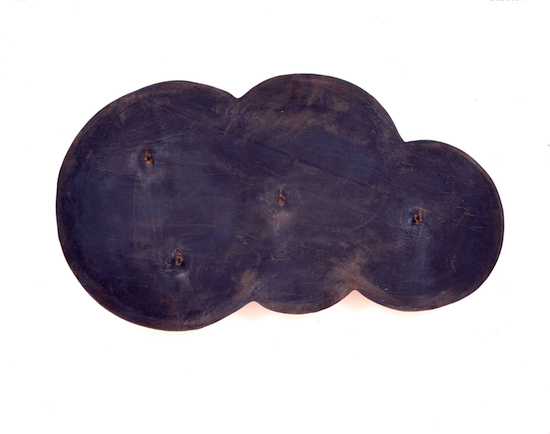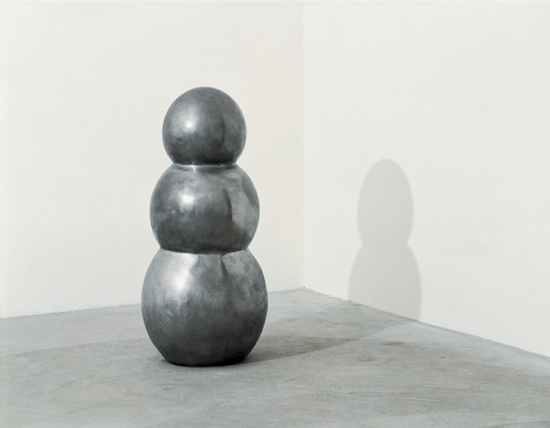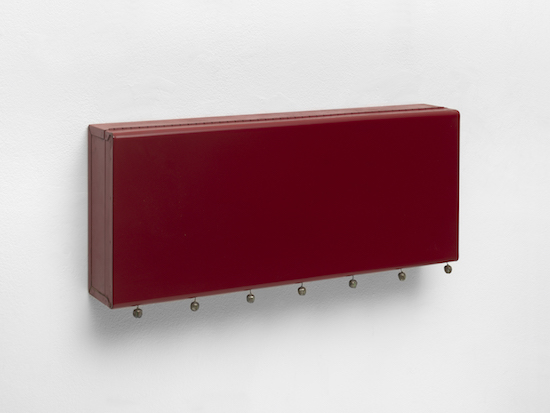Robert Therrien, No Title, 1989, Courtesy of Panza Collection,Mendrisio. Photography by Alessandro
Zambianchi – Simply. it, Milano
Californian artist Robert Therrien is not a well-known name, yet his objects are incredibly potent. In the UK, his best known work is probably No Title (Table and Four Chairs), 2003 (purchased by Tate and the National Galleries of Scotland as part of its Artist Rooms programme). Made of aluminium, steel, wood and plastic, the dining table and four chairs are painted to look like expensive, polished mahogany. But its most interesting feature is its colossal size: take a walk under that table to get the full effect – you’ll feel like you’ve been at the ‘Drink Me’ bottle.
Scaling up ordinary domestic objects to make them appear alienating, threatening or subtly anthropomorphic has become a familiar trope in contemporary art. Probably too familiar, since art abhors a cliché. A similar piece to Table and Four Chairs is Giancola Neri’s The Writer, which occupied a patch of Hampstead Heath in 2005. We might also think of Mona Hatoum’s towering kitchen utensils, or Jeff Koons and the startling verisimilitude and impressive scale of Play-Doh, though even Koons’ life-sized sculptures, such as Bear and Policeman, play with incongruities of scale.
Therrien plays with scale in earlier works, too, but the sculpture, drawings and reliefs at Parasol Unit, which take us from 1975 to 1995, have a different, fragile, more impermanent, quality. Presented on two floors, with 43 objects delightfully riffing off each other, it’s a terrifically engaging introduction to this artist if you’ve never encountered his work before, but even if you have it’s quite the revelation to see just how much more layered, allusive and intelligent his work can be beyond the sized-up furniture. This is an artist whose work is definitely not one-note.
So what do we find? Here we find a teetering plate precariously balanced on top of other objects on top of a plinth (a home-crafted take on Abstract Expressionist sculptor David Smith, perhaps); and, part of Therrien’s snowman series, an ascending arrangement of three globes, their smooth, tin-coated surfaces reflecting the light in such a way that they already look part liquid, like the quivering surface of a barely frozen lake.
We also find the motif of a bird in flight, just two arcing lines, nothing more, but which is repeated on different surfaces to intriguing effect; a bronze piece, which looks like tin, and whose shape suggests a dunce cap bent at the tip but which also makes you think of Brancusi’s soaring Bird in Space, just as those ascending globes wink at the modernist sculptor’s Endless Columns. And then there’s the artist’s cloud series: most delightfully – for this is nothing if not an exhibition full of enchantments – an aubergine-coloured cloud made of three flat, intersecting circles from which four rusty taps (once functional, now useless) sprout. You sense, like your encounter with the deliquescent snowman, that there’s more to this piece than mere playful whimsy.

Robert Therrien, No Title, 1991, Courtesy of Berlingieri Collection. Photography by Douglas M. Parker Studio
And it all looks so seductive. Much of the work looks as if it’s been reclaimed from an architectural salvage site: painted fragments, now chipped or with pleasingly distressed surfaces, from old wooden structures built long, long ago (the fairytale resonances aren’t accidental). Shapes find their echo, and among the recurring architectural motifs is a church arch and a church steeple: painted bright red, one huge panel of a church and steeple dominates one wall. Nearby is a silhouette of the same motif painted on a old round tray with a fat wooden frame – naïf, homely, unavoidably charming, giving off a Dutch homestead kind of vibe.
Everything is infused with an air of nostalgia, an air of enchantment, though you’re also aware Therrien is an artist very much grounded in American minimalism: he plays on notions of minimalist seriality and repetition – repeated modular units, à la Donald Judd, are given a delightful home-crafted twist; and he plays off the ideas of the giants of minimalism and their attachment to giantism.
You might, for instance, think of Richard Serra’s monumental steel sculptures when you see the huge Dutch door jutting out from a wall, the top section opening on its hinge at such an angle that it looks like one of Serra’s precariously balanced, two-part, big-block sculptures. And there’s a keyhole sculpture on a wall nearby, right at the entrance to the exhibition. The keyhole is a void made solid, a sculpture in bronze. Though it’s small enough to hold in your hand, it’s ridiculously big for a functional keyhole. What key would be big enough? But of course it’s not a keyhole but a solid object, just as the double-opening Dutch door is not a door but a sculpture. Ceci n’est pas une porte. And, lo, if that’s not some kind of bowler hat (a pleasing nod to Magritte, naturally) on a plinth further along.

Robert Therrien, No Title, 1985, Courtesy of Mary Patricia Anderson Pence. Photography by Douglas M. Parker Studio
And there’s something else going on too. You start noticing a Dutch theme running through the exhibition, unfolding and revealing itself in layers. The high steeple; the church arch; the work that resembles a Dutch planter; the recurring water pitcher that, now you actually think of it, reminds you of the pitcher in a Vermeer painting; the drawing with the child in a lace Dutch cap; and that keyhole again, whose shape has now been fashioned into the child wearing the Dutch cap and a traditional Dutch dress.
But Therrien’s work is not just a set of sophisticated art puzzles to decode, though much of its delight resides there. Its playfulness also tugs at something that resides deeper within – a sense of yearning for innocence and that longing to return to a state of containment, quietude and order. Just as you’ll find in those hushed interiors of 17th century Dutch painting. Mark this one up as one of this year’s exhibition highlights.
Robert Therrien: Works 1975 to 1995 at Parasol Unit until 11 December


